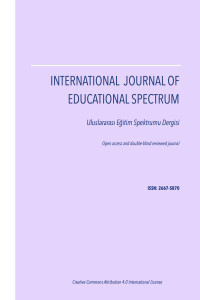İkinci dil sözlü üretiminde ingilizce edatlarin kullanimi
Hem birinci hem de ikinci dil çalışmalarında edatların edinilmesi ve kullanılması bir problem olarak güncelliğini korumaktadır (Celce-Murcia ve Larsen-Freeman 1999; Boers ve Demecheleer, 1998; Evans ve Tyler, 2004). Bu çalışma, anadili İngilizce olan ve Türkçe İngilizce öğretmenleri arasındaki edatların kullanım sıklığını incelemeyi amaçlamaktadır. Sözlü üretimi kaydetmek için veri çıkarma tekniği kullanılmıştır. Çocuk dil öğrenim çalışmalarında sıklıkla kullanılan bir resimli hikâye kitabı olan kurbağa öyküsü, verileri ortaya çıkarmak için kullanılmıştır. Çalışmaya 11 Türkçe Öğretmeni ve anadili İngilizce olan bireyler katılmıştır. Bu makale, (1) edatların kullanım sıklığını ve (2) çeşitli fiillerin kullanım sıklığına göre edatların kullanımında önemli bir fark olup olmadığını analiz etmeyi hedeflemiştir. Sonuçlar, iki grup arasında edatların kullanım sıklığı ve çeşitli fiillerin kullanımında anlamlı bir fark olduğunu göstermiştir.
Anahtar Kelimeler:
İngilizce edatlar, sözlü üretim, birinci ve ikinci dil edinimi
Use of English prepositions in L2 oral production
How acquisition and use of prepositions in both first and second language studies is an enigma (Celce-Murcia, & Larsen-Freeman 1999; Boers & Demecheleer, 1998; Evans & Tyler, 2004). This study intends to examine the frequency of use of prepositions between native speakers of English and Turkish teachers of English. An elicitation task was used to record the oral production. A frog story, a picture-story book which has been often used in child language learning studies, was employed as an elicitation task. The study involved 11 participants, Turkish Teachers of English and native speakers of English. This paper attempted to find answers to: (1) whether there is a significant difference in using prepositions according to frequency of use of prepositions and (2) use of various verbs. The results show that there was a significant difference between the two groups in terms of frequency of use of prepositions and use of various verbs.
Keywords:
prepositions, English prepositions oral production, acquisition, first and second language,
___
- Agoi F. (2003): Towards Effective Use of English: A Grammar of Modern English: Ibadan, Joytal Printing Press.
- Bedore, L. M., Peña, E. D., Anaya, J. B., Nieto, R., Lugo-Neris, M. J., & Baron, A. (2018). Understanding disorder within variation: Production of English grammatical forms by English language learners. Language, Speech, and Hearing Services in Schools, 49(2), 277-291.
- Celce-Murcia, M. & Larsen-Freeman, D. (1983). The grammar book: an ESL/EFL teachers course. Rowley, Massachusetts: Newbury House Publishers, Inc.
- Celce-Murcia, M. & Larsen-Freeman, D. (1999). The grammar book (2nd edition). Boston: Heinle and Heinle.
- Davy, B.Y. (2000). A cognitive-semantic approach to the acquisition of English prepositions Ph.D. diss., University of Oregon.
- Delshad, S. (1980). Persian and English prepositions compared and contrasted from a pedagogical point of view. Unpublished Ph.D. dissertation, USA: University of Texas
- Evans, V., & Tyler, A. (2004). Spatial experience, lexical structure and motivation. Studies in linguistic motivation, 157-192.
- Gass, S. M., & Mackey, A. (2012). Data elicitation for second and foreign language research. Routledge : London.
- Greenbaum, S., & Quirk, R., & Leech, G., & Svartvik, J. (!985). A comprehensive grammar of the English language. London: Longman.
- Gudmestad, A., & Clay, R. (2019). Prepositions in Contexts of Coordination: The Developmental Trajectory and Language Variation. Hispania, 102(1), 75-90.
- Haddad, M. T. A. (2018). The Impact of L1 Transfer on the Interaction of EFL Students with English Prepositions. In International Forum of Teaching and Studies (Vol. 14, No. 2, pp. 20-26). American Scholars Press, Inc.
- Hulstijn, J. H. (2010). Measuring second language proficiency. Experimental methods in language acquisition research, 185-199.
- Hung, B. P. (2019). Meaningful Learning and Its Implications for Language Education in Vietnam. Journal of Language and Education, 5(1), 98-102.
- Jach, D. (2018). A Usage‐Based Approach to Preposition Placement in English as a Second Language. Language Learning, 68(1), 271-304.
- Kang, J. Y. (2003). On the ability to tell good stories in another language: Analysis of Korean EFL learners' oral “frog story” narratives. Narrative Inquiry, 13(1), 127-149.
- Sanchez, L., & Jarvis, S. (2008). The use of picture stories in the investigation of crosslinguistic influence. TESOL Quarterly, 329-333.
- Swan M. & C. Walter (2000): How English Works: London, Oxford University Press.
- Shinkawa, S. H. (1979). English prepositions compared with Japanese de, ni, and o. In H. M. Taylor (Ed.), English & Japanese in contrast (pp.160-170). New York: Regents Publishing Company, Inc Shohamy, E. (2000). The relationship between language testing and second language acquisition, revisited. System, 28(4), 541-553.
- ISSN: 2667-5870
- Yayın Aralığı: Aylık
- Yayıncı: Hakan ULUM
